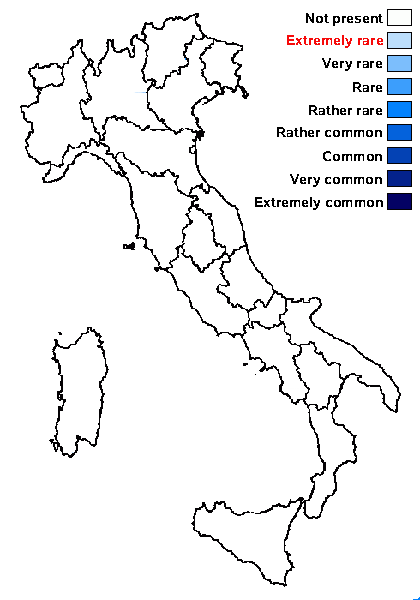Agonimia bryophilopsis (Vain.) Hafellner
in Nimis & al., MycoKeys, 31: 10, 2018.. Basionym: Polyblastia bryophilopsis Vain. - Acta Soc. Fauna Flora Fenn., 49, 2: 104, 1921.
Synonyms:
Distribution:
Description: Thallus crustose, episubstratic, whitish-grey, verruculose, subgelatinous when wet. Perithecia black, 0.3-0.4 mm across, subglobose, only basally immersed, mostly superficial. Exciple distinctly 2-layered, the outer layer dark brown, the inner layer pale brown to colourless; involucrellum absent; hymenial gel hemiamyloid; hamathecium of periphyses and periphysoids, interascal filaments absent. Asci 8-spored, clavate, thin-walled, fissitunicate with a very thin exoascus, surrounded by a hemiamyloid gel (K/I+ blue). Ascospores strongly muriform, with 35–55 cells in optical view, hyaline, ellipsoid, (28-)30-60(-75) x 15-25 μm. Photobiont chlorococcoid. Spot tests: K-, C-, KC-, P-, UV-. Chemistry: without lichen substances. Note: a poorly known species overgrowing mosses and plant debris on calcareous soil near or above treeline; apparently rare or not recognised, with several records in the Eastern Alps (Austria); to be looked for in the Italian Alps.
Growth form: Crustose
Substrata: soil, terricolous mosses, and plant debris
Photobiont: green algae other than Trentepohlia
Reproductive strategy: mainly sexual
Poorly known taxon in need of further study

Predictive model
Growth form: Crustose
Substrata: soil, terricolous mosses, and plant debris
Photobiont: green algae other than Trentepohlia
Reproductive strategy: mainly sexual
Poorly known taxon in need of further study

Predictive model
 Index Fungorum
Index Fungorum
 GBIF
GBIF

